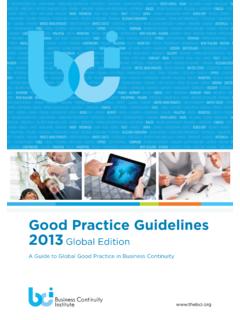Transcription of Clinic Business Continuity Plan Guidelines FINAL
1 Clinic Business Continuity plan Guidelines Clinic Business Continuity plan Guidelines November 14, 2013 i Emergency Notification Contacts Primary Role Name Address Home Phone Mobile/Cell Phone Clinic Business Continuity plan Coordinator EMR Vendor Business Continuity plan Coordinator Clinic EMR Liaison Clinic Communications Coordinator Contacts in case the EMR provider cannot be reached: Alberta Health Emergency Notification Contacts Backups (in case primary is unavailable) Role Name Address Home Phone Mobile/Cell Phone Business Continuity plan Coordinator Vendor Business Continuity plan Coordinator Clinic EMR Liaison Clinic Communications Coordinator Contacts in case the EMR provider cannot be reached: Alberta Health Clinic Business Continuity plan Guidelines November 14, 2013 ii Table of Contents Business Continuity plan .
2 1 plan Objectives .. 1 Assumptions .. 1 Disaster and Adverse Event Definition .. 2 Adverse Event Examples .. 2 Key Roles and Responsibilities .. 3 Disaster Declaration .. 5 Notification .. 5 Sample Responses to Adverse Events .. 5 Additional Information .. 6 Staff Contact List .. 8 BCP Role Contact List Primary and Alternate .. 8 Vendor Contact List .. 9 Provincial Government and Medical Association Contact List ..10 Sample Checklist ..11 Clinic Business Continuity plan Guidelines November 14, 2013 Page 1 of 11 Business Continuity plan A Business Continuity plan (BCP) assists organizations in planning for immediate and long-term response to adverse events and disasters. For physicians and clinics, BCPs outline the actions necessary to ensure continuance of patient care and Business operations.
3 This document as a summary of content that should be addressed when you develop your Business Continuity plan . Immediate response to adverse events and disasters may prevent loss of life and minimize injury to people and damage to property. Long-term response takes over after there is no threat to life or property. BCPs assure the long-term survival of the organization and develops organized responses to: Loss of the use of facilities such as an office or building. Inaccessibility of information and data (for clinics this relates specifically to medical records, schedules and billing). Unavailability of staff. Loss of medical equipment. Loss of technical resources such as hardware, software, Internet services and communication services. Anything else that may prevent normal operations or interfere with patient care and safety.
4 This plan is limited to major interruptions of service as outlined above where the ability to deal with and treat patients is curtailed for more than a one- or two-hour timeframe. plan Objectives The BCP: Serves as a guide for recovery. Identifies temporary Business activities required during interruptions. Identifies procedures and resources needed to assist in recovery. Identifies vendors, patients and other parties that must be notified in the event of a disaster. Assists in avoiding confusion that can be experienced during a crisis by documenting, testing and reviewing recovery procedures. Identifies alternate sources for supplies, resources and locations. Documents storage, safeguarding and retrieval vital records. Assumptions The BCP is based upon the following assumptions: Key people will be available following a disaster.
5 Broad scale disasters such as widespread flooding are beyond the scope of this plan . This plan relates only to disasters affecting the Clinic and its immediate environs. This document and all vital records are stored in a secure off-site location and are not impacted by the disaster. This plan will be accessible immediately in the event of a disaster. Clinic Business Continuity plan Guidelines November 14, 2013 Page 2 of 11 Each support organization, including the electronic medical record (EMR) vendor, will have its own plan consisting of appropriate recovery procedures and critical resource information. Disaster and Adverse Event Definition Disasters and adverse events are defined as any loss of utility service (power, water), connectivity (system sites) or catastrophic event (weather, natural disaster, vandalism, EMR service outage) that causes an interruption to the service provided by the Clinic .
6 The plan identifies vulnerabilities and recommends measures to prevent extended service outages. Adverse Event Examples BCPs address specific adverse events that pose a threat to a Clinic . They should consider and address possible threats whether man-made or natural, and the probability of those threats occurring. Threats and overall plans should be reviewed and evaluated annually. Threats include situations such as: Fire Flood Internal contamination ( Clinic or full building) Nearby contamination affecting access (train derailment, gas station leak, tanker truck accident) Infectious disease Theft Vandalism (internal and external) Extreme weather Loss of power Loss of telecommunications (Internet and/or phone) Temporary or permanent loss of key staff member(s) Denial of service (DNS) attack, malware infestation in Clinic or data centre Loss of data centre (and access to the Clinic data), destruction of data at data centre Widespread data corruption EMR vendor or other vendor failure (goes out of Business suddenly) This list is not definitive.
7 If other threats are a risk, they should be addressed by the BCP. Outcomes of these threats may include: Loss of access to the Clinic or building (temporarily or permanently). Loss of computer and or medical equipment. Loss of paper records or access to paper records. Loss of availability to electronic medical records including scheduling, billing and patient charts. Loss of specific knowledge regarding patients and or processes not documented by unavailable staff members. Temporary or complete loss of Business . Loss to third parties of patient data (privacy breach). Clinic Business Continuity plan Guidelines November 14, 2013 Page 3 of 11 Key Roles and Responsibilities When developing a BCP, specific roles and responsibilities need to be assigned.
8 The Clinic BCP coordinator, the EMR vendor BCP coordinator, the Clinic EMR liaison and the Clinic communications coordinator should have an identified alternate in case of non-availability. Clinic BCP Coordinator The Clinic BCP coordinator is a role undertaken by a designated lead physician or Clinic manager, with a clearly identified backup in case the lead is unavailable or indisposed. The Clinic BCP coordinator must: Determine how threats can be eliminated or mitigated. Develop plans to recover from damage caused by specific threats. Initiate and conduct periodic tests of the plan (once per year at a minimum). Hold the master copy of the plan and coordinate all updates. Retain an offsite copy of the BCP. Review and update the BCP on an annual basis. Initiate the execution of the BCP and coordinate its implementation when an adverse event occurs.
9 Train staff so they can fulfil their role(s) in the plan when it is implemented. Collect vital contact information for staff, building manager, suppliers, and insurance and restoration companies. Approve expenses such as new purchases, payroll and ongoing expenses. Accept overall responsibility for re-establishing normal operations. It is the Clinic BCP coordinator s responsibility to plan and execute recovery from the specific threats based on how quickly management decides the Clinic needs to recover and what they are willing to spend on recovery planning and processes. The Clinic BCP coordinator should consider the following: a. The impact on Business operations Patient care Patient safety How quickly the Clinic needs to recover before complete loss of Business How much loss can be tolerated How long the practice can survive if a critical person is unavailable or only partially available Banking, payroll, other Business functions b.
10 The resources that have been compromised Staff required (at a minimum) to operate the Business Required computer and medical equipment If new identification tokens (fobs) are necessary Required communication systems Alternate banking services Alternative billing processes Clinic Business Continuity plan Guidelines November 14, 2013 Page 4 of 11 c. Damage mitigation actions to consider Reducing hours of operation Using temporary employees or staff from other clinics Referring patients elsewhere Determining alternative methods for notifying staff and patients of disruption or closure Deciding who will enter or re-enter data once systems are available Determining the budget to develop the recovery strategy, what will be available following a significant event and how the funding will be accessed during recovery Securing back-up facilities that might be used; can arrangements be made with another Clinic or specialist?











